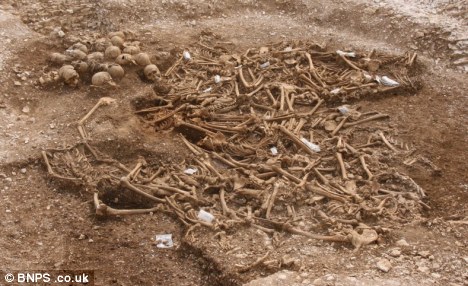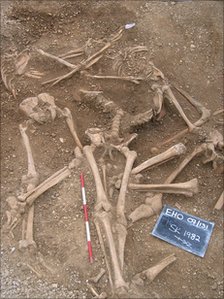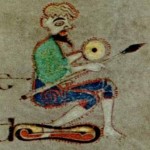The ninth and tenth centuries saw the arrival of a new force on the Irish political scene, the Vikings. These Scandinavian warriors were attracted by the wealth of the Irish monasteries and they came in search of booty and glory. The initial attacks were mainly confined to the coastline, but soon Viking bands were venturing far inland. Although a profitable enterprise, raiding could also be a deadly one, as many Vikings were to find out.
This is demonstrated by the large number of Viking warrior burials that have been found in Dublin city, as well by descriptions in the Irish Annals, which detail numerous occasions when Viking war bands were defeated by Irish kings. Among these many written accounts are descriptions of Viking losses to the Ulaid in AD 811, to the men of Brega in AD 837 and to the armies of Osraige in AD 846/847 when over 1200 Vikings are said to have died. The kings of Tara also inflicted routs on Viking forces, with 700 being killed in AD 848, 240 more in AD 866, while in AD 980 a crushing defeat of a large Viking army is described as a ‘red slaughter’. The descriptions of these battles in the Irish annals are terse but more information on what may have happened to these defeated Scandinavian warriors can be seen in some stunning excavation results from across the Irish sea in England.

At Weymouth, in the south of England, an excavation in 2009 by the Oxford Archaeology Unit revealed the remains of 51 decapitated men, mostly in their late teens and early twenties. They had been buried in mass grave, with their skulls carefully placed in one corner of the pit and their bodies dumped just a feet away (see above image). The decapitating blows which killed the men were hit with such force that cut marks were left on the victims, skulls, collar bones and jaws. A number of the skeletons also had evidence for blade marks on their arms suggesting that they had raised their hands in a vain attempt to shield themselves. Isotope analysis of dead men’s teeth indicated that they originated in Scandinavia; with one of the bodies probably belonging to someone who had lived most of their life within the Arctic Circle. Radiocarbon dating suggests that these young warriors died sometime between 910 and 1030AD, a time when England experienced a second wave of Viking raids along its southern coast. These unfortunate men appear to represent a Viking raiding party that were captured, stripped of their weapons and then summarily executed by the local Anglo-Saxons.

Interestingly, there were more bodies than skulls at Weymouth, which may indicate that some of the heads were kept as trophies. This is reminiscent of an account in the Irish Annals when Aed Finnliath, king of Tara and the Northern Uí Néill plundered all the longphoirt (Viking defended bases) of the north ‘a slaughter was made of them [the Vikings]. Their heads were collected to one place, in presence of the king; and twelve score heads were reckoned before him’ (Annals of the Four Masters, AD 864).

A second English site uncovered in Oxford in 2008, throws further light on what happened to Vikings who fell afoul of the locals. At this location a mass grave of young men, aged between 16 and 25, was uncovered by archaeologists working for Thames Valley Archaeological Services. There were at least 35 skeletons, all of which showed evidence of a violent death. Many of the skulls were covered in blade and puncture wounds that were mostly located to the back of the head. One of the victims had additional puncture wounds to his pelvis that seem to have come from behind him and from the side, as well as substantial blade wounds to his skull, suggesting that he had been attacked from all sides by at least by two different people. Indeed the pathology of the bodies, with wounds mainly located to the back of the torso and head, suggests that most of the men were slain as they tried to flee their attackers. Radiocarbon dating of the bones indicated that the young men were killed between AD960 and AD1020, which is very similar to those seen at Weymouth. Isotope analysis of their teeth indicated that they had a mainly seafood diet, which was very unusual for such an inland location. This and a number of other factors led the excavation archaeologists to believe that this group of young men represented another group of murdered Vikings.
As the Irish annals and these two archaeological sites graphically show, many young Scandinavian men left their homelands in search of riches and glory only to find a bloody death and a shallow grave. To go a ‘Viking’ was a perilous job indeed.
Related Posts
Links
BBC article on the Weymouth Vikings
BBC article on the Oxford Vikings




That reminds me, the Annals record that in 836 King Cearbhall of Ossory caught up with a Viking raiding party at the monastic site at Fearta Na gCaireach (Grangeferta, Co. Kilkenny), and took forty of their heads. I wonder what they did with the heads afterwards?
Usually the heads were “piked”, stuck on a pole as trophy’s and to scare others.
Thanks for the extra info Charles. I visited Grangeferta when we were testing along the N8. Didn’t spot any headless bodies in any of test trenches though! There must be loads of mass graves in Ireland, when you think of our troubled past. It would be interesting to see one dug.
I am a professional archaeologist who has done burials and I have to say that this article is well-written, and the claims based on the data seem to be sound. Very interesting article.
Also, I would like subscribe to this blog but the RSS link doesn’t seem to be working. Could the administrator pls do it manually, if possible. I include my email addy with this post. Thank you.
Really interesting piece. Could the two groups of men found ‘executed’ at Oxford be linked with the St Brice’s Day massacre of 1002, ordered by Aethelred II and known to have resulted in the burning to death of a number of Scandinavians at St Frideswide’s in Oxford? Probably worth noting that the deaths are unlikely to have occurred after 1017, when the war between Edmund and Cnut had ended and Danes and English lived in relative peace.
that was so so intresting about the vikings dead boddie and so cool!!!
Very nice! dedgbaeage
Fascinating.
Some old English churches have wooden doors covered with leather. And there are some legends that sometimes the leather was made from “Dane skins”.
So if the English hated viking raiders enough to tell such (true or false) stories about how viking raiders should be treated, it is easy to believe that sometimes they massacred vikings.
Skandinavian boys who dreamed of going viking were ignoring the fact that it was not such an easy path to fame and riches as they imagined.